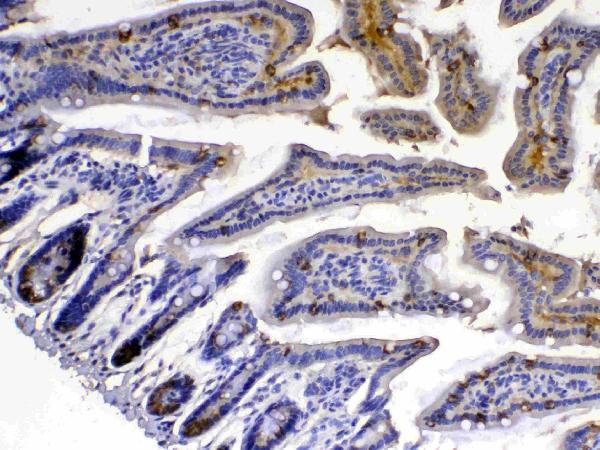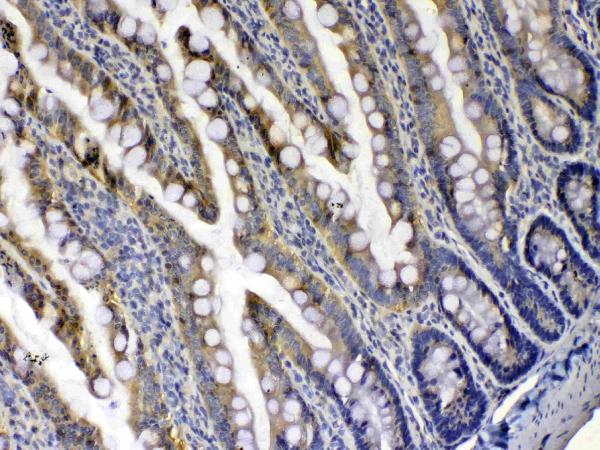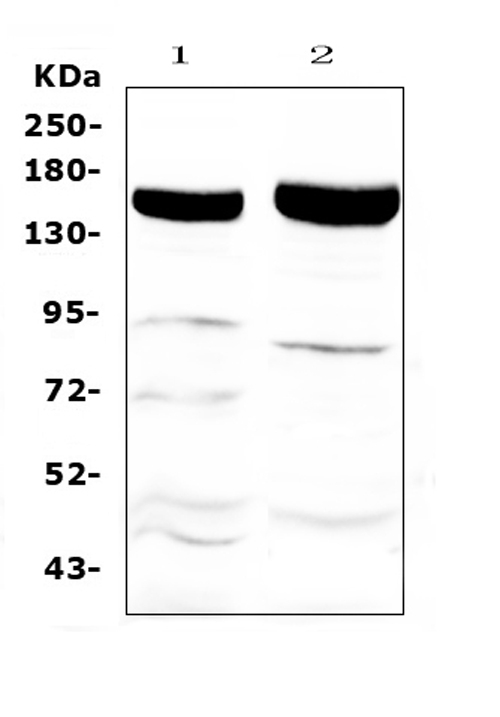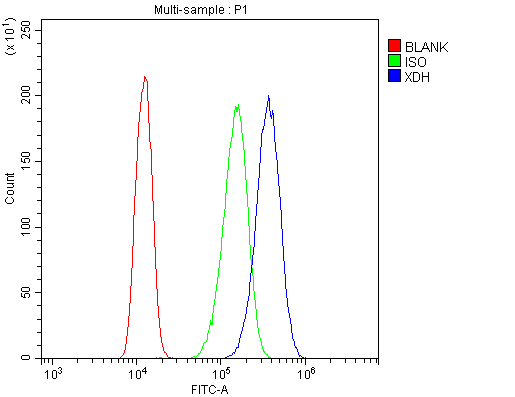Product Info Summary
| SKU: | A01884 |
|---|---|
| Size: | 100 μg/vial |
| Reactive Species: | Human, Mouse, Rat |
| Host: | Rabbit |
| Application: | Flow Cytometry, IHC, IHC-F, ICC, WB |
Customers Who Bought This Also Bought
Product info
Product Name
Anti-Xanthine Oxidase/XDH Antibody Picoband®
View all Xanthine Oxidase Antibodies
SKU/Catalog Number
A01884
Size
100 μg/vial
Form
Lyophilized
Description
Boster Bio Anti-Xanthine Oxidase/XDH Antibody Picoband® catalog # A01884. Tested in Flow Cytometry, IHC, IHC-F, ICC, WB applications. This antibody reacts with Human, Mouse, Rat. The brand Picoband indicates this is a premium antibody that guarantees superior quality, high affinity, and strong signals with minimal background in Western blot applications. Only our best-performing antibodies are designated as Picoband, ensuring unmatched performance.
Storage & Handling
Store at -20˚C for one year from date of receipt. After reconstitution, at 4˚C for one month. It can also be aliquotted and stored frozen at -20˚C for six months. Avoid repeated freeze-thaw cycles.
Cite This Product
Anti-Xanthine Oxidase/XDH Antibody Picoband® (Boster Biological Technology, Pleasanton CA, USA, Catalog # A01884)
Host
Rabbit
Contents
Each vial contains 4 mg Trehalose, 0.9 mg NaCl, 0.2mg Na2HPO4, 0.05 mg NaN3.
Clonality
Polyclonal
Isotype
Rabbit IgG
Immunogen
E. coli-derived human Xanthine Oxidase recombinant protein (Position: T2-K343). Human Xanthine Oxidase shares 86.8% and 89.2% amino acid (aa) sequence identity with mouse and rat Xanthine Oxidase, respectively.
*Blocking peptide can be purchased. Costs vary based on immunogen length. Contact us for pricing.
Cross-reactivity
No cross-reactivity with other proteins.
Reactive Species
A01884 is reactive to XDH in Human, Mouse, Rat
Reconstitution
Add 0.2ml of distilled water will yield a concentration of 500ug/ml.
Observed Molecular Weight
146 kDa
Calculated molecular weight
146424 MW
Background of Xanthine Oxidase
Xanthine dehydrogenase, also known as XDH, is a protein that, in humans, is encoded by the XDH gene. Xanthine dehydrogenase belongs to the group of molybdenum-containing hydroxylases involved in the oxidative metabolism of purines. The encoded protein has been identified as a moonlighting protein based on its ability to perform mechanistically distinct functions. Xanthine dehydrogenase can be converted to xanthine oxidase by reversible sulfhydryl oxidation or by irreversible proteolytic modification. Defects in xanthine dehydrogenase cause xanthinuria, may contribute to adult respiratory stress syndrome, and may potentiate influenza infection through an oxygen metabolite-dependent mechanism.
Antibody Validation
Boster validates all antibodies on WB, IHC, ICC, Immunofluorescence, and ELISA with known positive control and negative samples to ensure specificity and high affinity, including thorough antibody incubations.
Application & Images
Applications
A01884 is guaranteed for Flow Cytometry, IHC, IHC-F, ICC, WB Boster Guarantee
Assay Dilutions Recommendation
The recommendations below provide a starting point for assay optimization. The actual working concentration varies and should be decided by the user.
Western blot, 0.1-0.5μg/ml, Mouse, Rat, Human
Immunohistochemistry (Paraffin-embedded Section), 0.5-1μg/ml, Mouse, Rat, Human, By Heat
Immunohistochemistry (Frozen Section), 0.5-1μg/ml, Human
Immunocytochemistry, 0.5-1μg/ml, Human
Flow Cytometry (Fixed), 1-3μg/1x106 cells, Human
Positive Control
WB: rat liver tissue, mouse liver tissue
IHC: mouse intestine tissue, rat intestine tissue
FCM: A431 cell
Validation Images & Assay Conditions

Click image to see more details
Figure 2. IHC analysis of Xanthine Oxidase using anti-Xanthine Oxidase antibody (A01884).
Xanthine Oxidase was detected in paraffin-embedded section of mouse intestine tissue . Heat mediated antigen retrieval was performed in citrate buffer (pH6, epitope retrieval solution) for 20 mins. The tissue section was blocked with 10% goat serum. The tissue section was then incubated with 1μg/ml rabbit anti-Xanthine Oxidase Antibody (A01884) overnight at 4°C. Biotinylated goat anti-rabbit IgG was used as secondary antibody and incubated for 30 minutes at 37°C. The tissue section was developed using Strepavidin-Biotin-Complex (SABC)(Catalog # SA1022) with DAB as the chromogen.

Click image to see more details
Figure 3. IHC analysis of Xanthine Oxidase using anti-Xanthine Oxidase antibody (A01884).
Xanthine Oxidase was detected in paraffin-embedded section of rat intestine tissue . Heat mediated antigen retrieval was performed in citrate buffer (pH6, epitope retrieval solution) for 20 mins. The tissue section was blocked with 10% goat serum. The tissue section was then incubated with 1μg/ml rabbit anti-Xanthine Oxidase Antibody (A01884) overnight at 4°C. Biotinylated goat anti-rabbit IgG was used as secondary antibody and incubated for 30 minutes at 37°C. The tissue section was developed using Strepavidin-Biotin-Complex (SABC)(Catalog # SA1022) with DAB as the chromogen.

Click image to see more details
Figure 1. Western blot analysis of Xanthine Oxidase using anti-Xanthine Oxidase antibody (A01884).
Electrophoresis was performed on a 5-20% SDS-PAGE gel at 70V (Stacking gel) / 90V (Resolving gel) for 2-3 hours. The sample well of each lane was loaded with 50ug of sample under reducing conditions.
Lane 1: rat liver tissue lysate,
Lane 2: mouse liver tissue lysate.
After Electrophoresis, proteins were transferred to a Nitrocellulose membrane at 150mA for 50-90 minutes. Blocked the membrane with 5% Non-fat Milk/ TBS for 1.5 hour at RT. The membrane was incubated with rabbit anti-Xanthine Oxidase antigen affinity purified polyclonal antibody (Catalog # A01884) at 0.5 μg/mL overnight at 4°C, then washed with TBS-0.1%Tween 3 times with 5 minutes each and probed with a goat anti-rabbit IgG-HRP secondary antibody at a dilution of 1:10000 for 1.5 hour at RT. The signal is developed using an Enhanced Chemiluminescent detection (ECL) kit (Catalog # EK1002) with Tanon 5200 system. A specific band was detected for Xanthine Oxidase at approximately 146KD. The expected band size for Xanthine Oxidase is at 146KD.

Click image to see more details
Figure 4. Flow Cytometry analysis of A431 cells using anti-Xanthine Oxidase antibody (A01884).
Overlay histogram showing A431 cells stained with A01884 (Blue line). To facilitate intracellular staining, cells were fixed with 4% paraformaldehyde and permeabilized with permeabilization buffer. The cells were blocked with 10% normal goat serum. And then incubated with rabbit anti-Xanthine Oxidase Antibody (A01884,1μg/1x106 cells) for 30 min at 20°C. DyLight®488 conjugated goat anti-rabbit IgG (BA1127, 5-10μg/1x106 cells) was used as secondary antibody for 30 minutes at 20°C. Isotype control antibody (Green line) was rabbit IgG (1μg/1x106) used under the same conditions. Unlabelled sample without incubation with primary antibody and secondary antibody (Red line) was used as a blank control.
Protein Target Info & Infographic
Gene/Protein Information For XDH (Source: Uniprot.org, NCBI)
Gene Name
XDH
Full Name
Xanthine dehydrogenase/oxidase
Weight
146424 MW
Superfamily
xanthine dehydrogenase family
Alternative Names
Xanthine dehydrogenase/oxidase;Xanthine dehydrogenase;XD;1.17.1.4 ;Xanthine oxidase;XO;1.17.3.2 ;Xanthine oxidoreductase;XOR;XDH;XDHA; XDH XAN1, XO, XOR xanthine dehydrogenase xanthine dehydrogenase/oxidase|xanthine oxidoreductase
*If product is indicated to react with multiple species, protein info is based on the gene entry specified above in "Species".For more info on XDH, check out the XDH Infographic

We have 30,000+ of these available, one for each gene! Check them out.
In this infographic, you will see the following information for XDH: database IDs, superfamily, protein function, synonyms, molecular weight, chromosomal locations, tissues of expression, subcellular locations, post-translational modifications, and related diseases, research areas & pathways. If you want to see more information included, or would like to contribute to it and be acknowledged, please contact [email protected].
Specific Publications For Anti-Xanthine Oxidase/XDH Antibody Picoband® (A01884)
Hello CJ!
A01884 has been cited in 1 publications:
*The publications in this section are manually curated by our staff scientists. They may differ from Bioz's machine gathered results. Both are accurate. If you find a publication citing this product but is missing from this list, please let us know we will issue you a thank-you coupon.
Effect of Blueberry Anthocyanins Malvidin and Glycosides on the Antioxidant Properties in Endothelial Cells
Recommended Resources
Here are featured tools and databases that you might find useful.
- Boster's Pathways Library
- Protein Databases
- Bioscience Research Protocol Resources
- Data Processing & Analysis Software
- Photo Editing Software
- Scientific Literature Resources
- Research Paper Management Tools
- Molecular Biology Software
- Primer Design Tools
- Bioinformatics Tools
- Phylogenetic Tree Analysis
Customer Reviews
Have you used Anti-Xanthine Oxidase/XDH Antibody Picoband®?
Submit a review and receive an Amazon gift card.
- $30 for a review with an image
0 Reviews For Anti-Xanthine Oxidase/XDH Antibody Picoband®
Customer Q&As
Have a question?
Find answers in Q&As, reviews.
Can't find your answer?
Submit your question
7 Customer Q&As for Anti-Xanthine Oxidase/XDH Antibody Picoband®
Question
Is a blocking peptide available for product anti-Xanthine Oxidase/XDH antibody (A01884)?
Verified Customer
Verified customer
Asked: 2020-04-16
Answer
We do provide the blocking peptide for product anti-Xanthine Oxidase/XDH antibody (A01884). If you would like to place an order for it please contact [email protected] and make a special request.
Boster Scientific Support
Answered: 2020-04-16
Question
Can you help my question with product A01884, anti-Xanthine Oxidase/XDH antibody. I was wondering if it would be possible to conjugate this antibody with biotin. I would need it to be without BSA or sodium azide. I am planning on using a buffer exchange of sodium azide with PBS only. Would there be problems for me to conjugate the antibody and store it in -20 degrees in small aliquots?
Verified Customer
Verified customer
Asked: 2019-04-25
Answer
It is not recommended storing this antibody with PBS buffer only in -20 degrees. If you want to store it in -20 degrees it is best to add some cryoprotectant like glycerol. If you want carrier free A01884 anti-Xanthine Oxidase/XDH antibody, we can provide it to you in a special formula with trehalose and/or glycerol. These molecules will not interfere with conjugation chemistry and provide a good level of protection for the antibody from degradation. Please be sure to specify this in your purchase order.
Boster Scientific Support
Answered: 2019-04-25
Question
My question regards to test anti-Xanthine Oxidase/XDH antibody A01884 on mouse milk for research purposes, then I may be interested in using anti-Xanthine Oxidase/XDH antibody A01884 for diagnostic purposes as well. Is the antibody suitable for diagnostic purposes?
W. Carter
Verified customer
Asked: 2018-07-13
Answer
The products we sell, including anti-Xanthine Oxidase/XDH antibody A01884, are only intended for research use. They would not be suitable for use in diagnostic work. If you have the means to develop a product into diagnostic use, and are interested in collaborating with us and develop our product into an IVD product, please contact us for more discussions.
Boster Scientific Support
Answered: 2018-07-13
Question
I see that the anti-Xanthine Oxidase/XDH antibody A01884 works with Flow Cytometry, what is the protocol used to produce the result images on the product page?
Verified Customer
Verified customer
Asked: 2018-05-02
Answer
You can find protocols for Flow Cytometry on the "support/technical resources" section of our navigation menu. If you have any further questions, please send an email to [email protected]
Boster Scientific Support
Answered: 2018-05-02
Question
Do you have a BSA free version of anti-Xanthine Oxidase/XDH antibody A01884 available?
Verified Customer
Verified customer
Asked: 2018-03-28
Answer
We appreciate your recent telephone inquiry. I can confirm that some lots of this anti-Xanthine Oxidase/XDH antibody A01884 are BSA free. For now, these lots are available and we can make a BSA free formula for you free of charge. It will take 3 extra days to prepare. If you require this antibody BSA free again in future, please do not hesitate to contact me and I will be pleased to check which lots we have in stock that are BSA free.
Boster Scientific Support
Answered: 2018-03-28
Question
We are currently using anti-Xanthine Oxidase/XDH antibody A01884 for rat tissue, and we are happy with the WB results. The species of reactivity given in the datasheet says human, mouse, rat. Is it true that the antibody can work on zebrafish tissues as well?
N. Parker
Verified customer
Asked: 2015-09-29
Answer
The anti-Xanthine Oxidase/XDH antibody (A01884) has not been validated for cross reactivity specifically with zebrafish tissues, though there is a good chance of cross reactivity. We have an innovator award program that if you test this antibody and show it works in zebrafish you can get your next antibody for free. Please contact me if I can help you with anything.
Boster Scientific Support
Answered: 2015-09-29
Question
I was wanting to use your anti-Xanthine Oxidase/XDH antibody for Flow Cytometry for mouse milk on frozen tissues, but I want to know if it has been tested for this particular application. Has this antibody been tested and is this antibody a good choice for mouse milk identification?
J. Roberts
Verified customer
Asked: 2014-12-26
Answer
As indicated on the product datasheet, A01884 anti-Xanthine Oxidase/XDH antibody has been tested for Flow Cytometry, IHC-P, IHC-F, ICC, WB on human, mouse, rat tissues. We have an innovator award program that if you test this antibody and show it works in mouse milk in IHC-frozen, you can get your next antibody for free.
Boster Scientific Support
Answered: 2014-12-26





